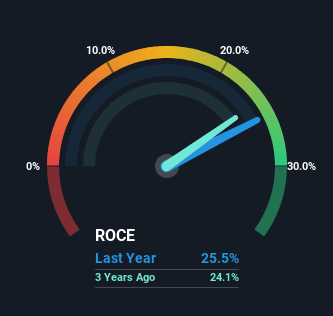Investors Met With Slowing Returns on Capital At Lockheed Martin (NYSE:LMT)
If we want to find a stock that could multiply over the long term, what are the underlying trends we should look for? Ideally, a business will show two trends; firstly a growing return on capital employed (ROCE) and secondly, an increasing amount of capital employed. Basically this means that a company has profitable initiatives that it can continue to reinvest in, which is a trait of a compounding machine. Having said that, while the ROCE is currently high for Lockheed Martin (NYSE:LMT), we aren't jumping out of our chairs because returns are decreasing.
Understanding Return On Capital Employed (ROCE)
For those that aren't sure what ROCE is, it measures the amount of pre-tax profits a company can generate from the capital employed in its business. The formula for this calculation on Lockheed Martin is:
Return on Capital Employed = Earnings Before Interest and Tax (EBIT) ÷ (Total Assets - Current Liabilities)
0.26 = US$9.1b ÷ (US$52b - US$17b) (Based on the trailing twelve months to December 2023).
Therefore, Lockheed Martin has an ROCE of 26%. That's a fantastic return and not only that, it outpaces the average of 9.7% earned by companies in a similar industry.
See our latest analysis for Lockheed Martin
Above you can see how the current ROCE for Lockheed Martin compares to its prior returns on capital, but there's only so much you can tell from the past. If you're interested, you can view the analysts predictions in our free analyst report for Lockheed Martin .
What Does the ROCE Trend For Lockheed Martin Tell Us?
Things have been pretty stable at Lockheed Martin, with its capital employed and returns on that capital staying somewhat the same for the last five years. This tells us the company isn't reinvesting in itself, so it's plausible that it's past the growth phase. So it may not be a multi-bagger in the making, but given the decent 26% return on capital, it'd be difficult to find fault with the business's current operations. This probably explains why Lockheed Martin is paying out 49% of its income to shareholders in the form of dividends. Unless businesses have highly compelling growth opportunities, they'll typically return some money to shareholders.
The Bottom Line
In summary, Lockheed Martin isn't compounding its earnings but is generating decent returns on the same amount of capital employed. Although the market must be expecting these trends to improve because the stock has gained 61% over the last five years. However, unless these underlying trends turn more positive, we wouldn't get our hopes up too high.
One more thing to note, we've identified 2 warning signs with Lockheed Martin and understanding them should be part of your investment process.
If you want to search for more stocks that have been earning high returns, check out this free list of stocks with solid balance sheets that are also earning high returns on equity.
Have feedback on this article? Concerned about the content? Get in touch with us directly. Alternatively, email editorial-team (at) simplywallst.com.
This article by Simply Wall St is general in nature. We provide commentary based on historical data and analyst forecasts only using an unbiased methodology and our articles are not intended to be financial advice. It does not constitute a recommendation to buy or sell any stock, and does not take account of your objectives, or your financial situation. We aim to bring you long-term focused analysis driven by fundamental data. Note that our analysis may not factor in the latest price-sensitive company announcements or qualitative material. Simply Wall St has no position in any stocks mentioned.

 Yahoo Finance
Yahoo Finance 
